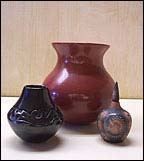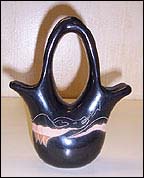Home
About Us
Current News
Event Calendar
Artist Bios
ARCHIVES
Display IDEAS
Collecting Tips
Gen Arts/Crafts Info
Testimonials
Hours/Directions
Online Store
ARCHIVES - Artist / Highlight of the Month
Santa Clara Pueblo Pottery - October 2005
The Highlight of the Month program at The Indian Craft Shop focuses on a particular craft area, region or artist family/group. Our aim is to illustrate the diversity of tribal groups and the wide variety of artistic expressions and traditions in the country today.


Santa Clara Pueblo pottery is a beautiful and prized art form that is both elegant and timeless. The Santa Clara Pueblo is located on the western side of the Rio Grande River, north of Santa Fe, New Mexico. This Tewa pueblo is well known for its highly polished red and black ware, a style of pottery with an oxidizing firing technique (for the black pottery) that is historic to many of the northern Rio Grande pueblos. The revival of this ancient pottery style began in the late 1930’s as potters, led by Maria Martinez of the San Ildefonso Pueblo, started creating pottery for the flourishing tourist market. Pueblo pottery, traditionally known for its utilitarian, ceremonial and religious uses, has also become a highly collected and prized art form today.
Using native materials and ancient techniques honed through the centuries, a variety of both traditional and contemporary works is being made today by the potters of Santa Clara Pueblo. Styles include the classic red and black ware, which can be plain or painted with mineral slips, the matte on black being most common. The pottery surface may be smooth or have carved designs, sometimes deeply carved, and sometimes very finely scratched in, a method called sgraffito.
Polychrome pottery, designs with three earth colors, is another classic style of pottery. Today artists may also incorporate the use of other slips and mineral or commercial paints to achieve the effect they desire. There are many shapes of pottery including wedding vases, classic bowls, melon bowls, seed bowls and jars, as well as miniatures and figurative pottery such as animals, mudheads and storytellers.
The pottery is often decorated with symbols that are significant to the Pueblo. Traditional designs include: the Avanyu, or water serpent in the quest for water, signifying life, prosperity and well-being; the feather pattern depicting the feathers of an eagle, signifying protection; the Kiva step signifying spirituality; and the bear paw representing strength and good health. Other designs include natural phenomena such as rain, hail, lightning, wind and clouds represented by different lines and step patterns. Some designs may be individual innovations of the artist, while others may be derived from history and still others may be a combination of both.
Today, ancient techniques can be combined with the use of modern implements to create masterful and stunning works of art. The relationship of artist to earth begins as it did generations before. Many travel to specific areas to collect the clay by hand, and to gather the temper that provides strength to the clay. Tempers used vary from one pueblo to another, with white pumice being most common at Santa Clara. The steps involved include gathering the clay, and then mixing it with temper in certain proportions, screening and rinsing several times with water to be sure it is just right. When the clay is ready, the traditional techniques of hand building and coiled pottery are used and then vessels are scraped and sanded, thinning out the walls and smoothing the pottery. The pottery is then coated with slips, clay and water mixtures, and either polished or decorated with design work. Perhaps the most intensive work of the potter is achieving the polished surfaces, the high sheen in both the red and black ware. Smooth stones are used, many of which have been passed down through the generations, becoming a treasured part of a family’s heritage.
Most pottery at Santa Clara Pueblo today is still fired outdoors in traditional pit fires. The clay for both red and black ware is the same, with the firing process determining if the finished pottery will be red or black. Pottery is placed in a metal container that has air holes, and a fire is built up around it. Toward the end of the firing process, which can take a few hours time, pieces are given their jet black color through the smothering of the outdoor fire. Manure, metal and other materials are used to cover the fire and block all air passage, thus oxidizing the pottery. For red ware, the fire is not smothered, allowing air to pass through and the pottery retains its red color. For the “sienna” or brown and black variation in color, potters often use a blow torch on the black ware. This torching actually “pulls out” the black color just in the places on the pot that are torched.
Santa Clara pottery is bold and dramatic, creating a high impact in any space. It is a way of life for many people at Santa Clara Pueblo with a long history of continuity. Each piece of pottery is a magical collage of knowledge, talent and techniques passed through generations, and it continues to evolve through today’s innovative potters.

Joe Baca (Santa Clara)
Joe Baca, a native of the Santa Clara Pueblo, is an artist who works in both contemporary and traditional styles. Known as both a businessman and a potter, Joe combines these talents in his own beautiful creations and in representing the work of other Santa Clara potters.
Born as Tsay Wing, meaning "Standing Spruce" of the Winter Moiety (clan), Joe studied in New Mexico, earning an MBA in Finance from the University of New Mexico in 1975. He worked on economic development projects on reservations, culminating with the design and creation of the American Indian Development Bank. Joe often observed other potters at Santa Clara, and began to make pottery himself in 1979. Self-taught, he was inspired by the work of potters from a variety of pueblos.
Joe collects the clay for his pieces near the village and uses traditional, contemporary, and realistic designs in his creations. He notes there are four basic designs on Santa Clara pottery, each with a symbolic meaning. These designs are the Avanyu, or water serpent, symbolizing prosperity and well-being; the feather of the eagle symbolizing protection; the kiva step symbolizing spirituality in life; and the bear paw, symbolizing strength and protection. In addition to these traditional designs, Joe uses symbols of nature, ancient Mimbres designs as well as others. He expertly etches designs into the pottery, sometimes adding color to the images. Joe also creates the black carved pots that are so well known at Santa Clara. Using ancient methods of hand coiling and hand polishing with agate stones, the pots are fired with cedar wood and horse manure to give birth to wonderful art objects.
Never content with the status quo, Joe is an artist who is always trying something new. On some pots he uses the sienna technique to burn carbon off a black pot in spots, turning them red or brown again. This technique requires a steady hand and alert eye, as the high temperature from an acetylene torch can damage a pot if it is not used carefully. Other pots have bright colors added from commercial ceramic paints, giving them a very contemporary look. Occasionally Joe will experiment, adding unexpected elements such as a mother of pearl button or plastic eye on a very modern fish.
Joe has won numerous awards and has exhibited at several shows to include Eight Northern Pueblos, Red Earth Festival, Indian Art Northwest, Eiteljorg Museum, the Heard Museum, Kituwah, Santa Fe Indian Market and Tesoro. He describes his pottery making best stating, "I strive to become one with the Spirit of the clay. Together we can make vessels of beauty for others to enjoy.”
©The Indian Craft Shop 2004


